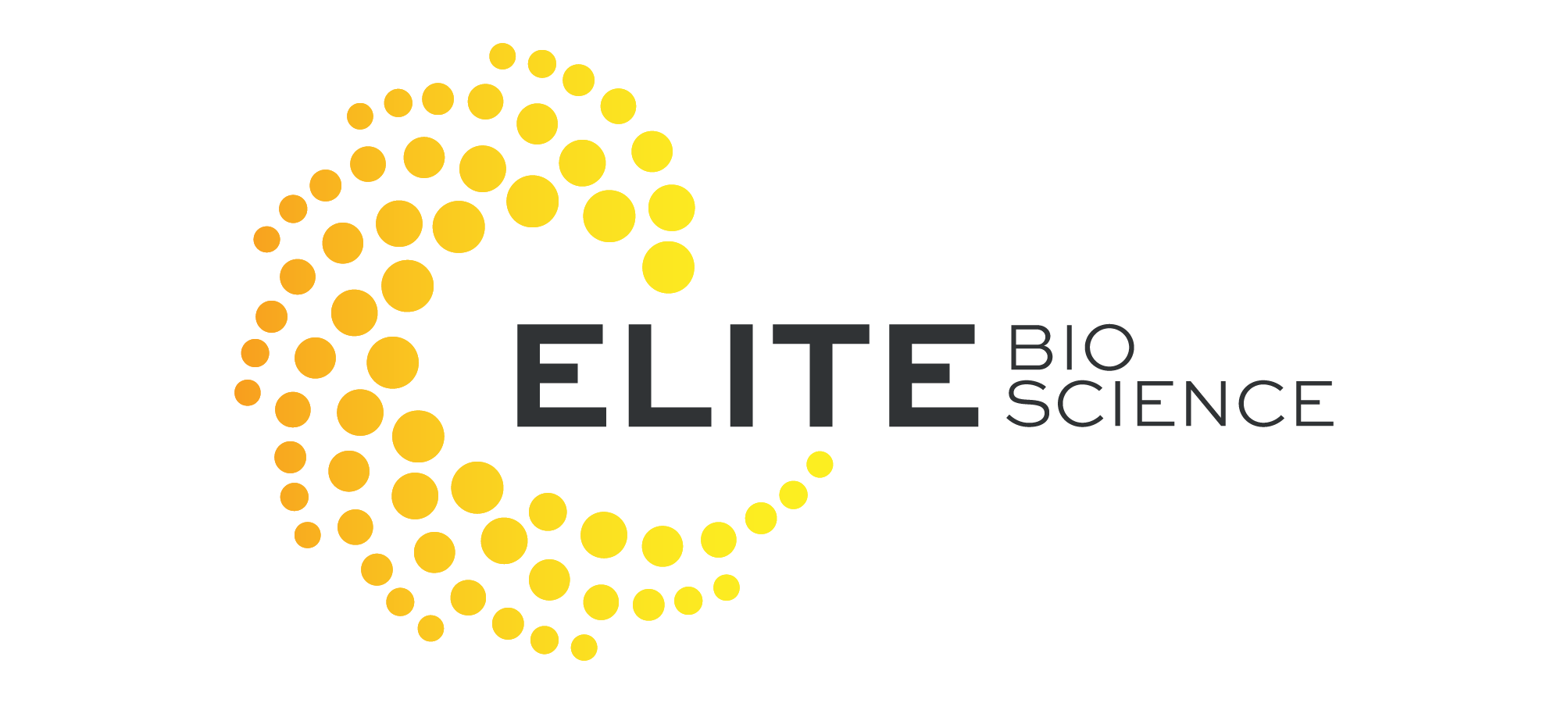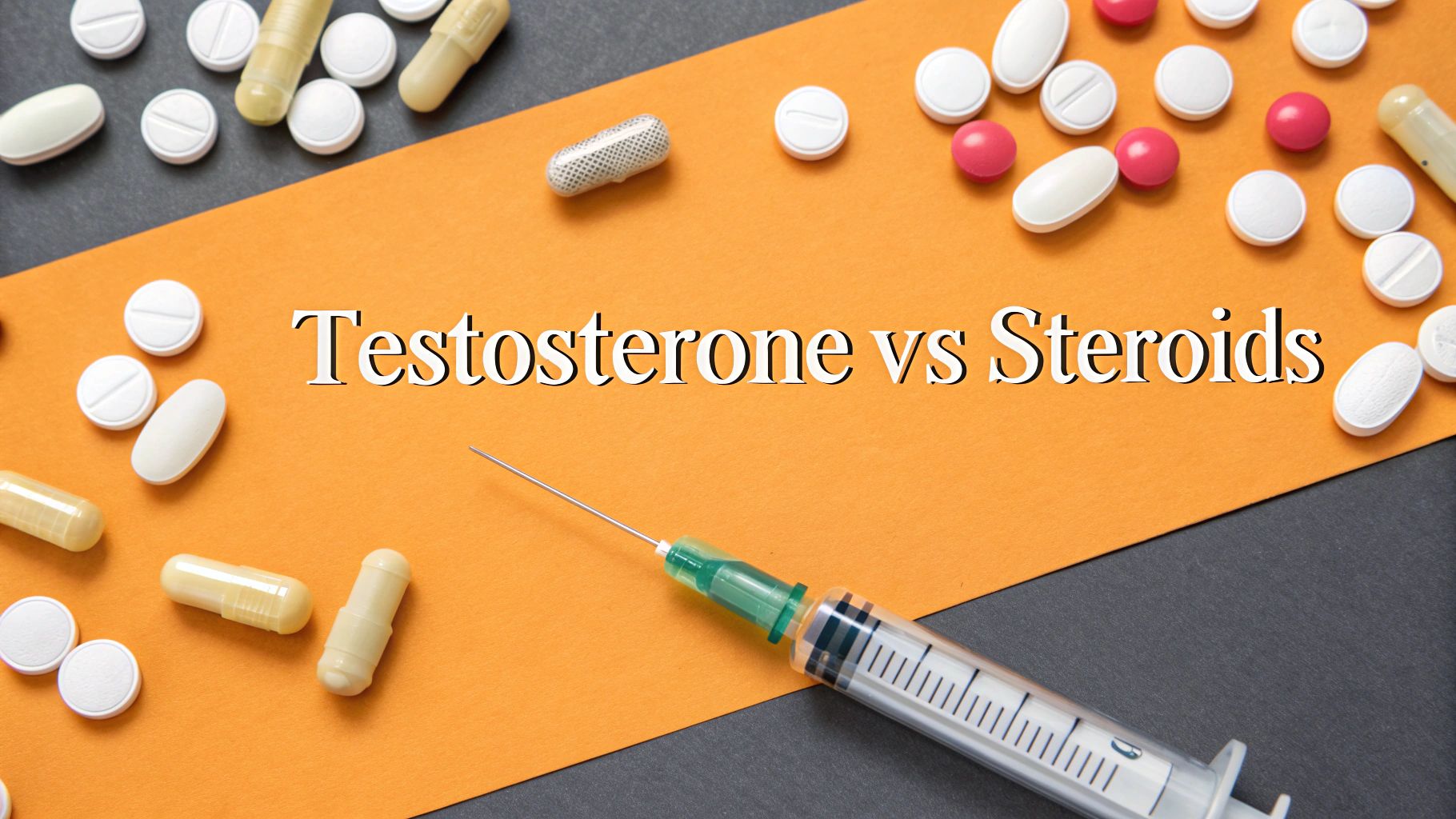Peptides for Skin A Guide to Youthful Skin

Peptides are essentially tiny messengers made of amino acids—the very same building blocks that make up the proteins in our skin. They work as powerful signaling molecules, telling your skin cells to get busy producing more of the good stuff like collagen and elastin. Think of them as the key to unlocking your skin's own rejuvenation processes, helping it become firmer, smoother, and healthier from the inside out. They've quickly become a foundational piece of any serious anti-aging strategy.
The Blueprint for Rebuilding Your Skin
Imagine your skin is a high-tech construction project that, over the years, has seen its most skilled workers—the ones responsible for building collagen and elastin—start to slow down. The structural integrity is still there, but repairs aren't happening as quickly, and new additions are rare. This is where peptides step in. They’re like the project managers arriving on-site with a fresh set of blueprints and a clear mandate to get production back on schedule.
These small but mighty molecules are able to penetrate the skin's outer layer and deliver very specific instructions directly to your cells. Instead of just patching over fine lines or adding temporary moisture, peptides go straight to the source. They signal your skin to ramp up production of the exact proteins it needs to repair damage and essentially act younger.
The Rise of Peptide-Driven Skincare
This targeted, biological approach is precisely why peptides have graduated from specialized scientific labs to the very forefront of the beauty and skincare industry. People are smarter than ever about what they put on their skin, actively looking for products with ingredients that are backed by real science. This demand has fueled incredible growth in the market.
In fact, the global peptide skincare serum market was valued at around USD 217.1 million and is expected to continue its steady climb. This isn't just a fleeting trend; it reflects a major shift toward preventative skin health and a desire for effective, non-invasive solutions. You can explore more data on peptide market trends to see just how significant their impact has become.
So, what does this mean for you? It means choosing products with peptides isn't just about trying the latest "it" ingredient. It's about adopting a scientifically sound strategy for long-term skin health.
By signaling cells to ramp up collagen production, peptides directly tackle the root causes of aging—like fine lines, wrinkles, and sagging—instead of just temporarily hiding the symptoms.
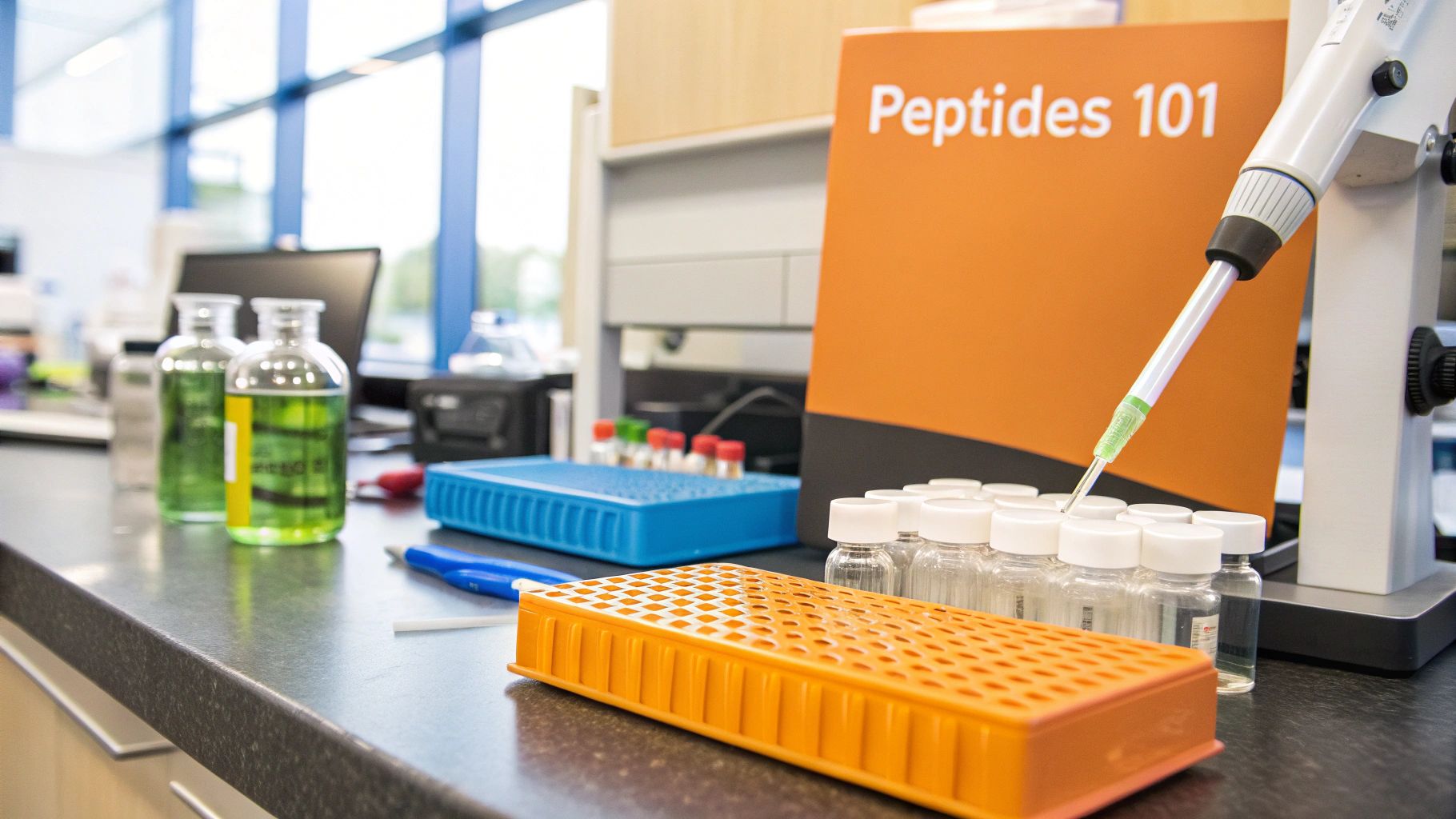
Here's another way to think about it: While some ingredients might offer a quick hit of hydration or a surface-level glow, peptides are the ones working overtime behind the scenes. They are fundamentally rebuilding and reinforcing your skin's deep structural layers, paving the way for lasting resilience and a genuinely healthier appearance.
To put it simply, peptides deliver a range of powerful benefits that address aging at its core. This table gives you a quick snapshot of what they do.
How Peptides Transform Your Skin
A quick summary of the primary benefits peptides deliver, helping you understand their value at a glance.
| Peptide Function | Impact on Skin Health |
|---|---|
| Stimulate Collagen Production | Reduces the appearance of fine lines and wrinkles for a smoother look. |
| Boost Skin Elasticity | Improves skin firmness and bounce, combating sagging. |
| Accelerate Skin Repair | Helps calm inflammation and supports the skin's natural healing processes. |
| Deliver Targeted Nutrients | Some peptides, like copper peptides, act as carriers for essential trace elements. |
As you can see, their roles are both specific and foundational. By incorporating them into your routine, you’re investing in the long-term structural health of your skin, not just its temporary appearance.
Meet the Peptides Powering Modern Skincare
Looking at a cosmetic ingredient list can feel like you’re back in high school chemistry class, but you don’t need a degree to understand peptides. The key is knowing that not all peptides are created equal—different types have highly specialized jobs. Think of them as a team of experts, each with a unique skill set, all working together to rebuild and protect your skin.
Once you can spot these key players, you can start choosing products with a clear purpose and finally understand what you're putting on your skin. Let’s meet the four main types of peptides that are getting real results in today’s skincare.

Signal Peptides: The Motivators
Signal peptides are basically the project managers for your skin. Their main job is to send powerful messages to your cells, telling them to ramp up production of essential proteins. As our natural collagen and elastin levels drop with age, signal peptides step in to get the assembly line moving again.
The most well-known example is Matrixyl (Palmitoyl Pentapeptide-4). When you apply it to your skin, it signals your fibroblast cells to start making new collagen. The result? Firmer skin and fewer visible wrinkles. It's essentially yelling, "Hey, build more collagen, now!" to your skin cells.
Carrier Peptides: The Delivery Specialists
Next on the team are the carrier peptides. Their mission is to stabilize and deliver vital trace elements, like copper and manganese, directly to your skin cells. These minerals are crucial for countless processes, especially wound healing and collagen synthesis. Without them, your skin’s repair functions just can't work at their best.
The undisputed star of this category is Copper Peptides (GHK-Cu). These peptides grab onto copper ions and carry them exactly where they’re needed most, supporting a whole host of regenerative activities. They’re famous for:
- Promoting wound healing by calming inflammation and kickstarting repair.
- Boosting collagen and elastin production for tighter, more resilient skin.
- Providing antioxidant effects to shield your skin from environmental stress.
By making sure these critical minerals arrive safely at their destination, carrier peptides act as a vital support crew for your skin's overall health.
Enzyme Inhibitor Peptides: The Guardians
While signal peptides are busy building new collagen, enzyme inhibitor peptides work to protect what you already have. Your skin naturally contains enzymes called matrix metalloproteinases (MMPs), which break down collagen. This is a normal part of skin turnover, but things like sun exposure and aging can send these enzymes into overdrive, causing premature sagging and wrinkles.
Think of enzyme inhibitor peptides as the security guards for your collagen. They intercept these destructive enzymes and stop them from wrecking your skin’s firm structure. Peptides derived from natural sources like rice and silk proteins are great examples. They help preserve your skin's firmness by slowing down that degradation process.
By protecting your existing collagen, these peptides play a critical defensive role. They ensure the new collagen stimulated by other peptides isn't immediately broken down before it has a chance to make a difference.
This protective action is a crucial piece of any smart anti-aging strategy. While some peptides focus on building, these are just as important for preserving what’s already there. And while many peptides focus on skin and hair, their versatility extends to other wellness goals; you might be interested in our guide on how peptides can support weight loss goals.
Neurotransmitter Inhibitor Peptides: The Muscle Relaxers
Last but not least, we have the neurotransmitter inhibitor peptides, which have earned the famous nickname "Botox in a bottle." These peptides work by targeting the communication pathway between nerves and muscles that causes your facial muscles to contract. By gently interfering with those signals, they help relax the muscles that form expression lines.
The most famous of this group is Argireline (Acetyl Hexapeptide-8). It works to soften the appearance of dynamic wrinkles—like crow’s feet and the lines on your forehead—that are caused by repeated facial movements. While it’s not as dramatic as an injection, consistent use can lead to a noticeable smoothing effect over time.
This incredible functionality is a huge reason the cosmetic peptide market is booming. Currently valued at around USD 257.4 million, the industry is projected to soar to USD 434.1 million on the back of scientifically validated ingredients like Argireline and Matrixyl. You can discover more insights about the cosmetic peptide market and its rapid expansion.
Knowing these different peptide types empowers you to build a routine that works on every level—building, delivering, protecting, and relaxing—for truly comprehensive skin rejuvenation.
Decoding the Science Behind Peptides
It’s one thing to read about peptides on the side of a fancy bottle, but it’s another to know if they actually work. To get past the marketing fluff and into real-world results, we need to look at what the science says. What does the research really show?
When scientists put an ingredient to the test, they aren’t just asking, “Does this make skin look a little nicer?” They’re looking for hard, measurable data. They measure things like wrinkle depth, skin elasticity, collagen density, and hydration levels over a set period. By translating those clinical studies into plain English, you can feel confident you’re investing in proven science, not just clever promises.
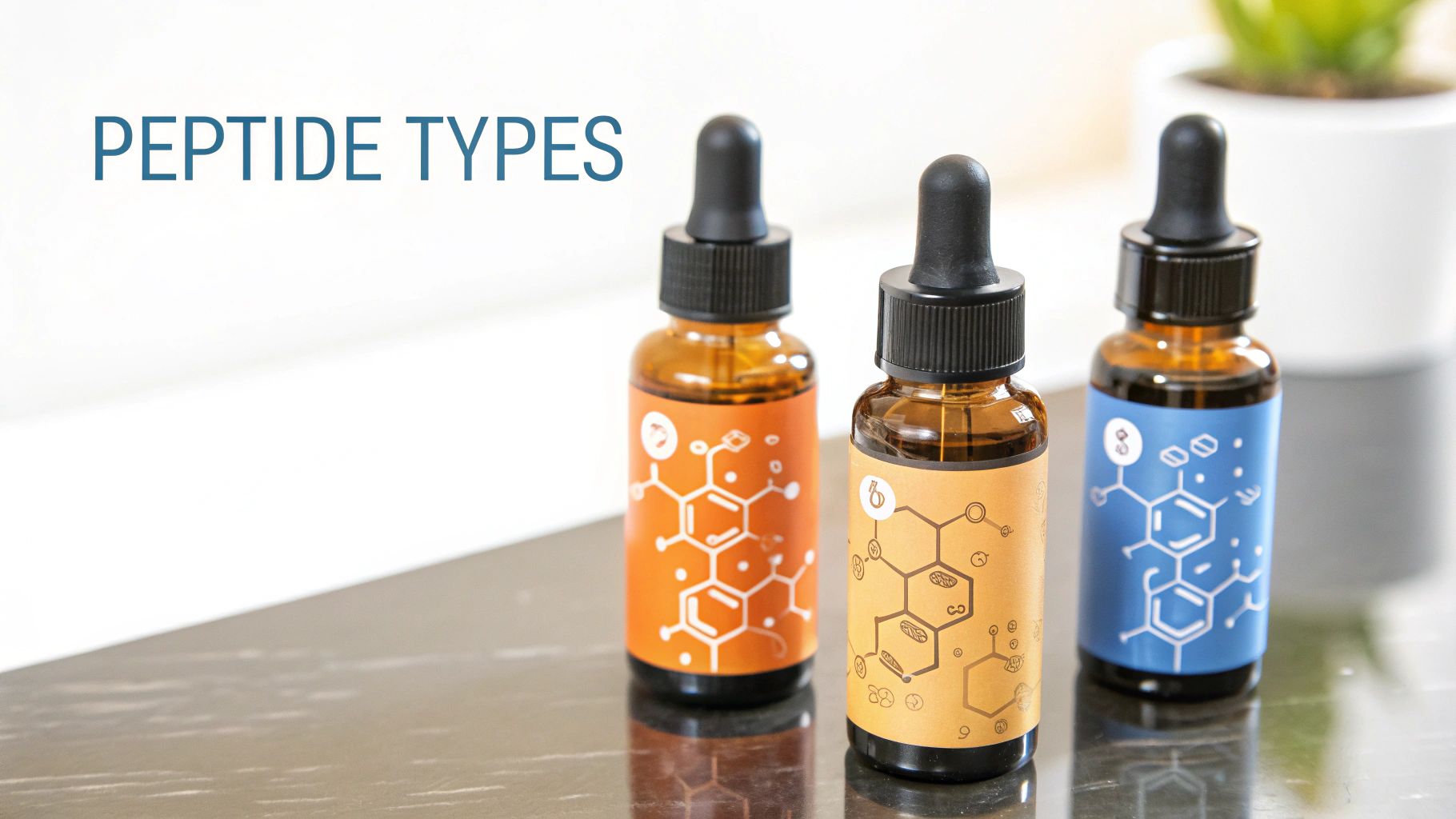
What the Evidence Shows for Key Peptides
One of the most heavily researched signal peptides out there is Matrixyl (Palmitoyl Pentapeptide-4). Time and time again, independent studies have shown its incredible ability to fire up new collagen production. The data consistently points to significant, visible improvements in skin texture and a reduction in wrinkles.
For example, multiple studies have documented a clear reduction in wrinkle depth and volume after just 8 weeks of consistent use. This isn't just a temporary plumping effect from hydration; it’s proof of genuine, structural change happening deep within the skin, all thanks to the peptide's signaling power.
Then you have Copper Peptides (GHK-Cu), which also have a mountain of scientific evidence behind them. Research shows they have a unique dual action: not only do they stimulate collagen, but they also have powerful anti-inflammatory and wound-healing properties. This makes them fantastic for improving overall skin health, calming redness, and speeding up repair.
In one key study, participants using a GHK-Cu cream showed a 31.8% improvement in skin laxity and a significant increase in skin density compared to a placebo. This really drives home its role in firming and rebuilding the skin’s foundational structure.
Why Formulation Is Everything
Here’s where things get tricky, though. The science also tells us that not all peptide products are created equal. Just seeing a peptide on an ingredient list doesn’t guarantee results. For the peptide in your serum to actually do its job, two things are absolutely critical: concentration and stability.
- Concentration: The peptide has to be included at a clinically effective percentage. A formula with just a tiny sprinkle for “label appeal” simply won’t deliver the same results as one formulated at the levels used in the studies.
- Stability & Delivery: Peptides are delicate little molecules. They need to be housed in a sophisticated delivery system that protects them from breaking down and helps them get past the skin’s tough outer barrier to reach the cells they need to talk to.
This is often where a product’s higher price point is justified. It reflects the investment in research and development needed to create a stable, effective formula that ensures the active ingredients can actually work. A well-formulated product from a reputable brand like Elite Bioscience ensures you're getting a therapy designed for maximum bioavailability and efficacy.
Becoming a Smarter Skincare Shopper
Once you understand this science, you can cut right through the marketing noise. Instead of being swayed by buzzwords, you can start looking for products that feature well-researched peptides like Matrixyl or GHK-Cu and come from brands that clearly prioritize formulation science.
The main takeaway here is that the benefits of peptides for skin aren’t just a theory. They are backed by a solid body of evidence demonstrating their ability to communicate with skin cells and trigger powerful regenerative processes. By choosing products based on this science, you’re making an informed decision to support your skin's long-term health and vitality.
Topical Serums Versus Injectable Peptides
When you start looking into peptides for your skin, you'll quickly find yourself at a fork in the road. One path leads to the skincare aisle, filled with topical peptide serums and creams. The other leads to a medical clinic, offering injectable peptide therapies. They might share a name, but they operate in completely different worlds. Understanding this distinction is the key to setting the right expectations and choosing the best route for your goals.
Think of it like this: topical peptides are highly skilled specialists you hire to work on the outside of a building—your skin's surface. Their job is to fix cosmetic issues like fine lines, loss of firmness, and uneven texture. You apply them directly to the skin, and their success depends entirely on a sophisticated formula that allows them to penetrate the outer layer and send signals to the cells just below.
The World of Topical Peptides
Topical peptides are designed with one primary mission: cosmetic skin improvement. When you see an ingredient like Matrixyl or Argireline listed on a serum bottle, you know its purpose is targeted and localized. It works within the skin's upper layers to kickstart collagen production or help relax expression lines right where you put it. Their effectiveness is a real testament to how far formulation science has come.
The market for these products is enormous and still growing as people seek out skincare backed by real science. The global peptide skincare serum market was valued at roughly USD 223 million, and it's projected to hit around USD 277 million. This growth shows just how mainstream these products have become, available everywhere from specialty stores and online retailers to dermatology clinics. You can read more about the peptide skincare market growth to see the full picture.
This chart drives home an important point: for topicals, consistency is everything.
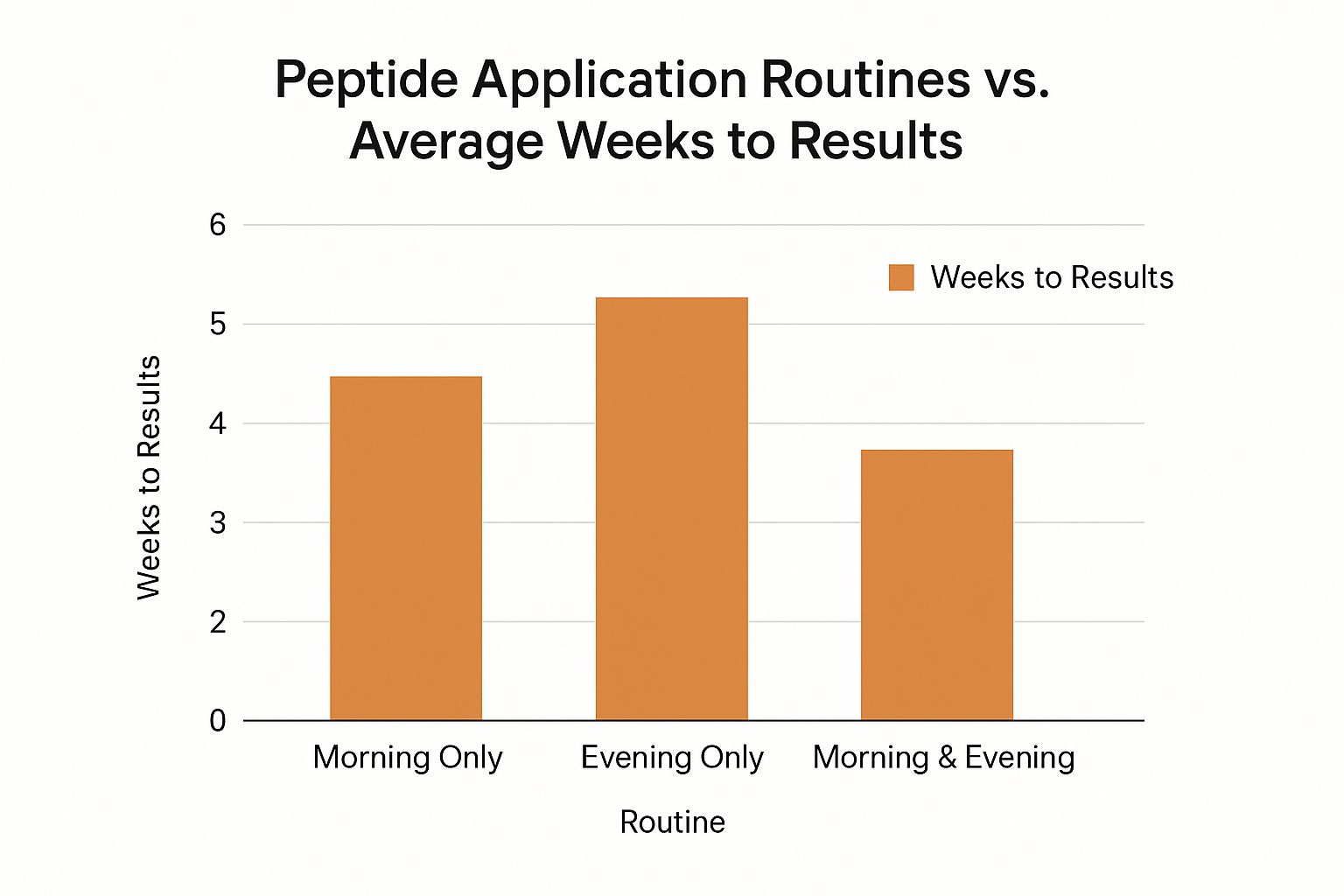
As you can see, a steady twice-a-day routine delivers the fastest results. It reinforces that with topical treatments, your commitment to the routine is what ultimately makes the difference.
Understanding Injectable Peptide Therapies
Injectable peptides, on the other hand, are like bringing in a chief engineer to manage a systemic overhaul of the entire building. These are medical-grade treatments, always administered by a qualified professional, that work from the inside out. Peptides like BPC-157 or CJC-1295/Ipamorelin are introduced directly into your bloodstream, allowing them to travel throughout the body and trigger systemic effects.
These therapies aren't just for your skin; they're used to chase broader health and wellness goals, such as:
- Accelerating tissue repair and healing after an injury.
- Reducing systemic inflammation throughout the body.
- Optimizing metabolic function and supporting body composition.
- Boosting overall cellular regeneration and vitality.
While better-looking skin is often a welcome side effect of injectable peptides, it's typically a bonus—a result of the body's improved overall health and repair systems, not the main goal of the therapy.
Topical Serums vs Injectable Peptides A Comparison
So, how do you decide which path is right for you? It really comes down to your primary objective. Are you focused on tackling specific cosmetic concerns on your skin’s surface, or are you looking for a deeper, systemic approach to your overall health and vitality?
This table provides a simple breakdown to help you compare the two.
| Feature | Topical Peptide Serums | Injectable Peptide Therapies |
|---|---|---|
| Primary Goal | Cosmetic skin improvement (e.g., wrinkles, firmness). | Systemic health and wellness (e.g., tissue repair, anti-aging). |
| Application | Applied directly to the skin, usually twice daily. | Administered via injection under medical supervision. |
| Scope of Action | Localized to the area of application. | Systemic, affecting the entire body. |
| Accessibility | Widely available over-the-counter and online. | Requires a prescription from a licensed medical professional. |
| Best For | Targeting specific signs of aging on the face and neck. | Addressing whole-body wellness, with skin benefits as a bonus. |
Ultimately, both approaches offer powerful benefits, but they operate in completely different realms. Topical serums are your go-to for dedicated cosmetic skincare. Injectable therapies, like those we provide at Elite Bioscience, represent a medical strategy for achieving deep-seated wellness and vitality. Knowing the difference empowers you to make an informed choice that truly aligns with your personal health and beauty ambitions.
Alright, let’s talk about the fun part—actually getting these powerhouse peptides into your daily skincare routine. Now that you have a solid grasp of the science, putting them to work is where the magic happens. It’s not complicated, but a little strategy goes a long way in making sure you see the best possible results from your investment.
Think of building your skincare routine like assembling a high-performance team. You need to send your players out in the right order so they can do their jobs effectively. The great news is that peptides are fantastic team players; they get along with most other ingredients, which makes them incredibly easy to slot into your existing lineup.
Before we get into the specifics, let's cover the single most important rule: Consistency is non-negotiable. Peptides work by delivering cumulative benefits, meaning their effects build up with steady use over time. Using them sporadically just won't cut it if you’re looking for those visible improvements in skin firmness, texture, and overall radiance. To truly see a difference, you need to commit to applying your peptide product twice a day, every day.
Building Your Morning Routine
Your morning routine has one primary mission: to protect your skin from the environmental assaults it will face all day. This is where peptides fit in beautifully, providing a supportive base layer that works in tandem with your other protective products. They are typically lightweight and absorb quickly, prepping your skin perfectly.
Here’s a simple, effective way to layer in the morning:
- Cleanser: Start with a gentle face wash. You need a clean canvas for your products to penetrate properly.
- Toner (Optional): If a toner is part of your routine, swipe it on now.
- Vitamin C Serum: Apply your antioxidant serum first. This is your frontline defense against free radical damage from UV rays and pollution.
- Peptide Serum: Now it's time for the peptides. Gently pat the serum into your skin, allowing it to sink in.
- Moisturizer & Sunscreen: Lock in all that goodness with a hydrating moisturizer, and then—the most critical step—finish with a broad-spectrum sunscreen of SPF 30 or higher.
This sequence allows each ingredient to perform at its peak. The Vitamin C acts as a protective shield on the surface, while the peptides get to work underneath, signaling collagen production throughout the day.
Peptides and Vitamin C are a true powerhouse combination. Vitamin C creates a more stable skin environment, which can significantly boost the effectiveness of signal peptides trying to rebuild that youthful collagen.
Crafting Your Evening Routine
Nighttime is all about repair and regeneration. As you sleep, your skin’s natural healing mechanisms kick into high gear. This is the prime opportunity to give your skin a boost with targeted ingredients like peptides and retinoids that support this restorative process.
An ideal evening layering order looks like this:
- Double Cleanse: The first cleanse (oil-based) breaks down makeup and sunscreen, while the second (water-based) washes away the day’s grime.
- Toner (Optional): Apply your hydrating or gentle exfoliating toner.
- Peptide Serum: Apply your peptide product to clean, slightly damp skin to maximize absorption.
- Retinoid (Retinol): Give the peptide serum a minute or two to fully absorb, then apply your retinoid.
- Moisturizer: Finish with a nourishing cream to seal everything in, hydrate your skin, and support your skin’s protective barrier.
Using a peptide serum before a retinoid can also be a game-changer for sensitive skin. It can act as a gentle buffer, helping to minimize the potential irritation that some people experience with retinol.
Important Ingredient Interactions
While peptides play well with almost everything, there is one key interaction you need to be aware of.
- Copper Peptides and Vitamin C: You’ll want to avoid using copper peptides in the exact same step as direct acids, especially L-Ascorbic Acid (a very potent form of Vitamin C). The low pH of the acid can destabilize the copper peptide, potentially making both ingredients less effective. The fix is simple: use your Vitamin C in the morning and save your copper peptide product for your nighttime routine. An excellent formula like Elite Bioscience’s GHK-Cu Copper Peptide is perfect for your evening repair cycle.
By following these straightforward layering principles, you can take all the guesswork out of incorporating peptides for skin into your daily regimen and build a truly powerful anti-aging strategy.
Is It Safe to Put Peptides on Your Skin?
Whenever you’re thinking about adding a powerful new player to your skincare lineup, it’s smart to ask about safety. So, what’s the verdict on peptides for skin? The news is overwhelmingly good. Topical peptides are widely seen as one of the safest and most gentle anti-aging ingredients you can get, especially when you compare them to heavy-hitters like retinoids, which often come with a whole lot of initial irritation and peeling.
Because peptides are something your skin already makes and understands, the risk of a bad reaction is incredibly low. Most people add them to their routine and never look back. Still, just like with any skincare product, a very small number of people might notice some minor, temporary sensitivity.
How to Spot and Sidestep Irritation
The most common side effects—which are still quite rare—are usually minor and don't last long. You might notice things like:
- A bit of redness where you applied the product
- A mild itching or warm feeling
- Slight skin sensitivity after application
More often than not, these little reactions are caused by other ingredients in the formula, not the peptides themselves. This is exactly why a patch test is always a good idea. Before slathering a new peptide serum all over your face, try a small amount on a hidden spot, like your inner wrist or behind your ear. Give it 24 hours to see how your skin feels.
A quick patch test is your best defense. It lets you confidently introduce new products, minimize the risk of a full-blown reaction, and make sure the formula is a great match for your unique skin.
Why Quality Comes at a Cost
You’ve probably noticed that top-tier peptide serums carry a higher price tag. This isn't just clever marketing; it’s a direct reflection of the sophisticated science needed to make a product that actually delivers results. A peptide's ability to work is entirely dependent on its formulation.
Several key factors drive up the cost:
- Stability: Peptides are delicate little messengers. If they aren't protected in a stable formula, they can break down and become completely useless.
- Penetration: The formula has to be smart enough to get the peptides past your skin’s tough outer layer. It needs a specialized delivery system to shuttle them down to the cells they need to communicate with.
- Concentration: To get real, visible results, a product needs to contain peptides at a clinically proven concentration—not just a sprinkle for "label appeal."
When you invest in a well-formulated peptide product, you're paying for the research and technology that ensures those peptides are stable, can get where they need to go, and are present in a high enough amount to truly make a difference. Knowing this helps you understand that you're investing in skincare that is not only effective but also backed by science. For a much deeper dive into this topic, you can learn much more about whether peptide therapy is safe in our detailed guide. At the end of the day, understanding what you’re paying for gives you the confidence that your skincare choices are sound.
Your Questions About Peptides, Answered
Jumping into the world of peptides can bring up a few last-minute questions. It’s smart to get a clear picture before adding any new powerhouse ingredient to your skincare lineup, especially one as effective as peptides.
To make sure you feel completely confident, let's tackle some of the most common questions with straightforward, practical answers. Think of this as your final check-in before building a routine you can count on for the long haul.
How Quickly Will I See Peptide Results?
When it comes to peptides, patience and consistency are your two best friends. While you might notice some hydrating and plumping effects almost right away, the real magic is happening on a deeper level over time. Peptides are essentially sending a message to your skin to rebuild its own support structures, and that kind of construction project is a gradual process.
Typically, you can expect to see real, visible improvements in skin firmness, elasticity, and a softening of fine lines within 4 to 12 weeks of consistent, twice-daily use. Sticking with it is absolutely essential, as the benefits build on themselves day after day.
Can I Combine Peptides with Other Actives?
Absolutely! In fact, peptides are fantastic team players. They work exceptionally well with other skincare heavy-hitters, forming a powerful anti-aging lineup that can seriously boost the effects of your existing routine.
Here’s a simple way to combine them for maximum impact:
- With Vitamin C: In your morning routine, apply your Vitamin C serum first to get that crucial antioxidant protection. Let it absorb, then follow up with your peptide serum.
- With Retinol: In the evening, you can apply your peptide product either before or after your retinol. Applying it before can sometimes act as a gentle buffer, which is a great trick for reducing potential irritation if you have sensitive skin.
This combination ensures you’re tackling skin aging from every possible angle—protecting from future damage, speeding up cell turnover, and actively rebuilding from within.
By using peptides, vitamin C, and retinol together, you create a well-rounded routine that addresses past damage, protects against future stress, and actively rebuilds a healthier, more youthful skin matrix.
Are More Expensive Peptide Serums Worth It?
This is a great, and very common, question. While a high price tag doesn't automatically mean a better product, with peptides, it often reflects the serious investment that goes into quality research, premium ingredients, and a sophisticated delivery system.
A well-formulated product from a trusted brand is usually a smarter choice than a budget option. Cheaper formulas might lack stability or use a concentration of peptides that’s too low to do much of anything. The real value is in the science that ensures those peptides can actually get through the skin barrier and deliver their message effectively.
Do Peptides Work for Every Skin Type?
Yes, and this is one of the biggest advantages of using peptides for skin. They are known for being incredibly versatile and are generally very well-tolerated by all skin types, including sensitive, oily, and even acne-prone skin.
Because peptides are just short chains of amino acids—the very building blocks already present in your skin—the risk of irritation or a bad reaction is extremely low. This makes them a safe and effective ingredient for pretty much everyone looking to improve their skin's health and appearance.
Ready to harness the power of science-backed therapies for your health and wellness goals? Explore how Elite Bioscience provides expertly formulated peptide and vitamin treatments, prescribed by doctors and delivered directly to you. Start your journey to optimized health today.
QUICK SEARCH
Make an account today to start your journey towards a better and healthier lifestyle.
